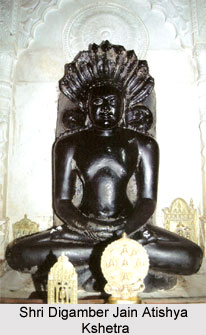 Digambar Jain Atishya Kshetra, Nemgiri Samsthan is located in Jintur. The temple serves as a popular pilgrimage centre. It is located in the Parbhani District that is 3 km away from Jintur. The cities located near Jintur are Aurangabad which is 160 km away and Nandel that is 110 km. The Sahyadris Mountain Range on which the temple is situated offers a panoramic view of the scenic beauty that surrounds the temple. Many ancient Jain Caves, Temples and Chaityalayas can also be seen here on the two hills Nemgiri and Chandragiri. These caves and temples are famous for their artistic beauty.
Digambar Jain Atishya Kshetra, Nemgiri Samsthan is located in Jintur. The temple serves as a popular pilgrimage centre. It is located in the Parbhani District that is 3 km away from Jintur. The cities located near Jintur are Aurangabad which is 160 km away and Nandel that is 110 km. The Sahyadris Mountain Range on which the temple is situated offers a panoramic view of the scenic beauty that surrounds the temple. Many ancient Jain Caves, Temples and Chaityalayas can also be seen here on the two hills Nemgiri and Chandragiri. These caves and temples are famous for their artistic beauty.
History of Digamber Jain Atishya Kshetra
According to history the temples of Digambara Jain Atishya Kshetra are very ancient and are believed to be more than 2500 years old. These temples were built by the Emperor Amogh Varsha of Rashtrakuta Dynasty. However, the temples were later destroyed by the invaders. Presently only temples are left. Later in the year 1609 A.D. these temples were reconstructed by Shri Veer Sangavi. It is believed that this Atishya Kshetra was visited by Samavsharan of Lord Mahavira. It is also said that the Last Shrut Kevali Acharya Bhadrabahu along with his 12000 scholars installed the famous idol of Lord Parshvanatha. According to archaeologists the idols of this Kshetra are nearly 1000 years old.
Main Temple of Digamber Jain Atishya Kshetra
The main temple of Jain Atishya Kshetra located in Parabhani district houses 7 caves. These caves are dedicated to Lord Adinath, Lord Shantinath, Lord Neminath and Lord Parshvanatha. The biggest idol of these caves is of Lord Neminath. The idol is seated in a Padmasana posture and is about 6.5 feet in height. The idol of Lord Parshvanatha is of about 6 ft. It is placed on a small 2 cm stone.
In Nemgiri Hill a beautiful idol of Lord Antariksha Parsvanath is situated in Cave No. 5. It is placed in the cave 3 inches high from surface. The idol is almost 6.5 feet in height and has nine serpent hoods over head. Another beautiful idol of Lord Neminath can be seen in Cave No.4. The idol is seated in a cross legged posture and is almost 7.5 feet in height.
The second hill, Chandragiri Hill has a Choubeesee that has been carved on a flat rock. It has been done in a very artistic way. It houses great standing idols of Lord Shantinath, Kunthunath and Arahnath. These idols were installed in V.S. 1665.
Apart from these there are many other temples located here. In first cave the idol of Lord Mahavira is installed. It is 3.5 feet in height and is seated in cross legged posture. This idol was installed in V.S. 1676. In second cave there is an ancient idol of Lord Adinath in state of meditation and penance. The third cave houses a image of Lord Shantinath. It is 6 feet in height and is seated in a cross legged posture. In sixth cave there is an ancient idol in standing posture with four heads in four directions. The seventh cave is dedicated to Lord Bahubali. It is 5.5 feet in height in a standing posture.
There are 2 old temples in Jintur city. These are ancient idols that have been ruined by invaders. In one of the temples an idol of goddess Padmawati is installed. The deity has four hands which are decorated with ornaments. A standing idol of Lord Parshvanath is also located here. The idol is 3 feet 10 inches in height and was installed in Shaka Samvat 1514.




















